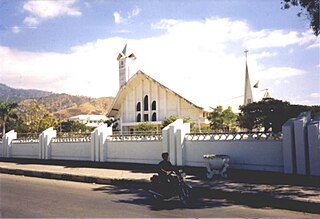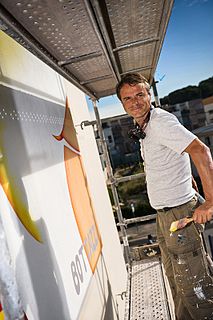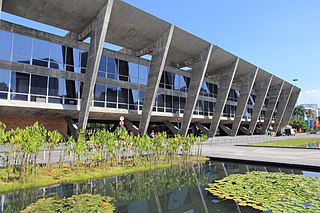Arte Moris (meaning "Living Art" in Tetun) is the first fine arts school, cultural center and artists’ association in East Timor. It is based in the capital, Dili.

East Timor or Timor-Leste, officially the Democratic Republic of Timor-Leste, is a country in Maritime Southeast Asia. It comprises the eastern half of the island of Timor, the nearby islands of Atauro and Jaco, and Oecusse, an exclave on the northwestern side of the island surrounded by Indonesian West Timor. Australia is the country's southern neighbour, separated by the Timor Sea. The country's size is about 15,410 km2.

Dili, also known as “City of Peace”, is the capital, largest city, chief port, and commercial centre of East Timor (Timor-Leste). Dili is part of a free trade zone, the Timor Leste–Indonesia–Australia Growth Triangle (TIA-GT).
Founded following the violent Indonesian occupation, "Its primary aim was to use art as a building block in the psychological and social reconstruction of a country devastated by violence, with special emphasis on helping its young citizens."

Indonesia, officially the Republic of Indonesia, is a country in Southeast Asia, between the Indian and Pacific oceans. It is the world's largest island country, with more than seventeen thousand islands, and at 1,904,569 square kilometres, the 14th largest by land area and the 7th largest in combined sea and land area. With over 261 million people, it is the world's 4th most populous country as well as the most populous Muslim-majority country. Java, the world's most populous island, contains more than half of the country's population.
Arte Moris provides art classes to local East Timorese, sponsors advanced students, and manages the sale of artwork, both at their on-site gallery and at two up-scale hotels in Dili. Arte Moris also collaborates with the professional drama troupe Bibi Bulak ("Crazy Goat").

Drama is the specific mode of fiction represented in performance: a play, opera, mime, ballet, etc, performed in a theatre, or on radio or television. Considered as a genre of poetry in general, the dramatic mode has been contrasted with the epic and the lyrical modes ever since Aristotle's Poetics —the earliest work of dramatic theory.
Bibi Bulak Performance Arts and Music Troupe is a professional drama and music troupe based in East Timor. They are linked to the Timorese art school Arte Moris and share facilities with them at the Arte Moris Cultural Centre in Comoro Dili.
The art center is housed on the former premises of the National Museum in Comoro, near Dili.
The artwork produced at the school is wide-ranging, but is often surrealist in style, and exhibits cultural aspects from the varied regions of the country.

Surrealism is a cultural movement that began in the early 1920s, and is best known for its visual artworks and writings. Artists painted unnerving, illogical scenes with photographic precision, created strange creatures from everyday objects, and developed painting techniques that allowed the unconscious to express itself. Its aim was to "resolve the previously contradictory conditions of dream and reality into an absolute reality, a super-reality".
The Culture of East Timor reflects numerous cultural influences, including Portuguese, Roman Catholic, and Malay, on the indigenous Austronesian cultures in East Timor.

Lasar Segall was a Lithuanian Jewish and Brazilian painter, engraver and sculptor. Segall's work is derived from impressionism, expressionism and modernism. His most significant themes were depictions of human suffering, war, persecution and prostitution.

The National University of East Timor, based in the East Timorese capital Dili, is the major institution of higher education in East Timor.

Baucau is the second-largest city in East Timor, after Dili, the capital, which lies 122 km east of Dili.

Dili is one of the 13 municipalities, formerly districts, of Timor-Leste, which includes the national capital Dili. It had a population of 277,279 as of 2015, most of whom live in the capital city. The municipality has an area of 368.12 km2 (142.13 sq mi). The municipality continued the same name as the council had in Portuguese Timor.

The Singapore Biennale is a contemporary art biennale in Singapore. The first Singapore Biennale operated as one of a lineup of Singapore 2006 events. Fumio Nanjo, Director of Tokyo's Mori Art Museum, has been reappointed Artistic Director of the Singapore Biennale 2008. Working with Mr Nanjo on Singapore Biennale 2008 are two curators: independent curator Joselina Cruz, formerly a curator at the Singapore Art Museum and the Lopez Museum in Manila; and Matthew Ngui, one of Singapore's leading artists in contemporary art.

Guillaume Bottazzi is a French visual artist.

The Museum of Modern Art in Rio de Janeiro (MAM) is a museum located in northeastern Flamengo Park, in the city of Rio de Janeiro, Brazil. It is in the Centro district, west of Santos Dumont Airport, on Guanabara Bay.
Nahum B. Zenil is a Mexican artist who often uses his own self-portrait as the principal model for a cultural critical interpretation of Mexico, especially concerning homosexuality and mestization. Zenil was born in 1947 in the state of Veracruz. In 1959, he enrolled at the Escuela Nacional de Maestros in Mexico City, from which he graduated in 1964. It was during this period in which Zenil became interested in painting. He later entered the Escuela Nacional de Pintura y Escultura in Mexico City in 1968. He is also one of the founding members of the Semana Cultural Gay, which occurs yearly at the Museo Universitario del Chopo. His art is often compared to that of Frida Kahlo, in which the self becomes the principal object of their paintings letting the viewer discover the artists as individuals as well as the broader social and cultural contexts in which they lived through the medium of self-portraiture.

The Olot school of landscape painting is a group of painters that created an artistic style in the second half of the 19th century. It includes not simply artists from Olot, but all artists whose artworks were inspired by the countryside of Olot. By extension, artists connected with Olot and its comarca, Garrotxa.
Gustavo Arias Murueta is a Mexican painter, sculptor and poet, a member of the Salón de la Plástica Mexicana best known for his work in drawing, graphic arts and oil painting. He originally studied architecture at the Universidad Nacional Autónoma de México where he met artists such as Rufino Tamayo, David Alfaro Siqueiros and José Clemente Orozco. In the 1950s, he began to produce artworks, with his first exhibition in 1961. From then until the present he has had a career as an artist with individual and collective exhibitions in both Mexico and abroad. While his work has been heavily influenced by Orozco, he is considered part of the Generación de la Ruptura movement.
Roberto Donis was a Mexican painter and art teacher. He began studying art at the Escuela Nacional de Pintura, Escultura y Grabado "La Esmeralda", but unsatisfied with the instruction, helped organize a student strike. It was unsuccessful and rather than return to school, he decided to go to Morelia to teach. Donis’ art career consisted of exhibitions both in Mexico and abroad, including an important exhibition at the Museo de Arte Moderno in Mexico City and accepted as a regular with the prestigious Galería de Arte Mexicano. His teaching career included directorship at the Universidad Autónoma Benito Juárez as well as helping to found the Taller de Artes Plásticas Rufino Tamayo in the city of Oaxaca. He received several recognitions for his work, including membership in the Salón de la Plástica Mexicana.
Naomi Siegmann was an American artist who has developed her career in Mexico, and noted for the depiction of everyday objects outside their normal contexts. She began her career after she moved to Mexico with her family, learning to carve wood. She worked in this medium for about twenty years, before moving onto other materials, including recycled ones, in part due to her concerns for the environment. During her career, she had solo exhibits in Mexico and the United States, with participation in collective exhibits in these countries and Europe. She has been commissioned to create monumental works in Mexico and the United States. Her work has been recognized through a membership in the Salón de la Plástica Mexicana.

QSI International School of Dili, is a school located in Fatuhada,beside palm Spring estate Dili, East Timor. It is one of a chain of schools operated by Quality Schools International The school has 79 students representing 21 countries.The school has American curriculum based classes ranging from preschool to secondary levels. It offers students the opportunity to learn and do extracurricular activities. It was accredited by the Middle States Association of Colleges and Schools.
Rocio Caballero is a Mexican figurative painter, whose works often depict mythical worlds and are noted for her use of symbolism. Her work has been exhibited individually and collectively in Mexico, the United States, South America and Europe and can be found in collections such as that of the National Museum of Mexican Art. Her work has been recognized with membership in the Salón de la Plástica Mexicana.

Indochristian art, or arte indocristiano, is a type of Latin American art that combines European colonial influences with Indigenous artistic styles and traditions.
ESTE ARTE is an international art fair held annually every January in Punta del Este, Uruguay. It presents international art galleries, which showcase both established and newly emerging artists. In addition to the artworks shown by participating galleries, the fair offers parallel programming including seminars by experts open to the public, debates hosted by different artists, shows featuring sound art and scheduled guided visits.
ESTE ARTE brings an artistic offering that ranges from historical avant-gardes to emerging and contemporary art. While ESTE ARTE provides the platform for galleries to show and sell their work to collectors, museum directors, and curators, it also attracts a large international audience of art spectators and students.














